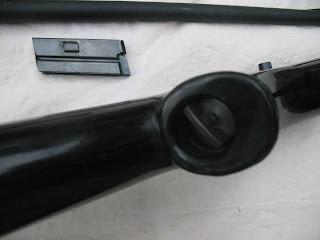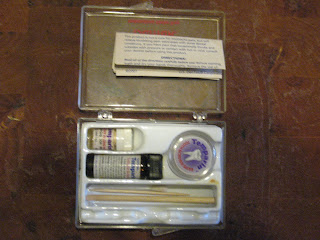The AR-7 is a little .22 caliber auto-loader. It is an interesting gun because the barrel
and receiver disassemble and store in the stock making a veer small and
lightweight package. I've always been
curious to own one of these little rifles, so when I saw one at a recent gun
show for a hundred dollars, I picked it up.
Pictured below: Charter Arms AR-7
The AR-7 was designed by Eugene Stoner and manufactured
originally by Armalite in hopes that the military would adopt it as a
replacement for the AR-5 bolt action survival rifle. Things didn't work out so Armalite began
selling the AR-7 on the civilian market.
Over the years the design and manufacturing right were sold to Charter
Arms and then the Henry Co. The AR-7 that
I bought was made by Charter Arms which I have read did not produce the best
version of this product.
The stock of the gun is a synthetic that is filled with
foam. Supposedly the gun will float if
dropped in water, but I haven't tried this personally. The barrel is made of aluminum with a rifled
steel inner sleeve and unscrews from receiver.
Pictured below: Barrel unscrewed from receiver
A thumb screw on the bottom of the stock allows the receiver
to be detached from the stock. Pictured below: Screw that holds receiver in place
When assembled the rifle is 35 inches long. Disassembled and with the barrel and receiver
stored in the stock, the AR-7 is 16 inches long. The total weight of this weapon is 2.5
pounds. Pictured below: AR-7 broken down
and packed
The AR-7 is chambered for .22 longrifle. It is an auto-loader with a blow-back bolt
and double bolt springs. The factory
magazine holds eight rounds. Pictured below: top, Magazine in mag port, bottom,
magazine removed
The bolt springs are fairly stiff and will only cycle
reliably with high velocity ammo. .22
longs, short, and CB's will not operate the bolt although they can be single
loaded and fired. Round nose bullets are
said to load more reliably, but I always buy hollow points so that's what I am
using in this test.
The AR-7 is intended as a survival weapon. This means small game at fairly close range,
so I am going to be firing it on a thirty yard range. The sight on the AR-7 is a fixed blade on the
front with a rear peep-sight that is removable but not adjustable. Pictured below: Rear peep sight
I am no sharpshooter, so I decided that in case I just
wasn't shooting any good I would fire from the same distance, and from the same
prone position with the AR-7, a Hi Standard .22 revolver, a Savage combo gun in
.22 over 20 ga., and a Ruger 10-22. I
could then compare the targets and see how the AR-7 performed against other
weapons.
The results were not very favorable for the AR-7. It was the worst performer of the four
weapons fired. Of the first eight rounds
fired through the AR-7, I had two jams.
These jams were not from failure of a round to chamber properly. They were caused by failure of the extractors
to pull the fired rounds from the chamber.
Because the bolt doesn't lock back I had to manually hold the bolt open
while pulling out the spent cartridge case with my pocket knife. A real pain.
Of the eight rounds fired only six cut paper and they were all over the
place; no consistent pattern whatsoever.
Pictured below AR-7 target number one.
I ran eight more rounds this time with only one jam, but I
only got two rounds on the paper. I'm
not a great shot, but I'm not that bad.
Pictured below: AR-7 target number 2.
Next I fired eight rounds through the Hi Standard
revolver. No misfires and all eight
rounds on the target. Seven of the
rounds were within a six inch circle.
Pictured below: Hi Standard revolver and target.
As pictured below the Savage combo put all eight on the
paper including one bull, and the Ruger 10-22, predictably, shot the tightest
group including one bull. Pictured
below: top, Savage target; bottom, Ruger target
So when all is said and done I would say that if you have
the opportunity to buy a Charter Arms AR-7, don't. If you are looking for light-weight and
compactness, a good quality revolver will out perform the Charter Arms
AR-7. I can't tell you about the
Armalite or Henry versions of the AR-7, and I have heard that they are of
higher quality. But as for the Charter
Arms……..save your money.






















